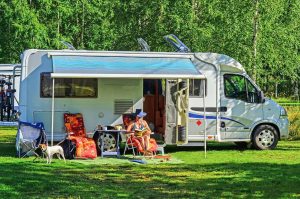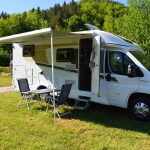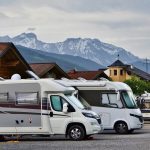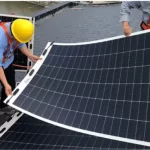Table of Contents
- Introduction
- 1. What is Full-Time RV Living?
- 2. Is Full-Time RV Living Right for You?
- 3. How Much Does Full-Time RV Living Cost?
- 4. How to Prepare for Full-Time RV Living
- 5. How Do People Make Money While Living in an RV?
- 6. How Do You Stay Connected on the Road?
- 7. What’s It Like Living in an RV in Winter?
- 8. Safety, Security & Community on the Road
- 9. Best States for Full-Time RV Domicile
- FAQs About Full-Time RV Living
- Conclusion
Introduction
Full-time RV living is more than just a travel trend—it’s a lifestyle revolution. Whether you’re a digital nomad, early retiree, or freedom-seeker, the appeal of waking up in new places each week is undeniable. But what does it really take to live on the road full-time? This guide explores what full-time RV living is all about, its pros and cons, how much it costs, and how to prepare for a successful life on wheels.
1. What is Full-Time RV Living?
➤ What is the meaning of RV life?
RV life means embracing a lifestyle centered around mobility, minimalism, and adventure. It’s about trading traditional housing for a recreational vehicle that becomes your primary home—whether you’re parked in national parks, traveling cross-country, or boondocking in remote locations.
➤ What is an RV meaning?
An RV, or Recreational Vehicle, is a mobile dwelling that combines transportation with living accommodations. RV types include:
Class A Motorhomes – large and luxurious
Class B Campervans – compact and efficient
Class C Motorhomes – a mix of space and driveability
Fifth Wheels & Travel Trailers – towable units for those with trucks
➤ How does RV life work?
RV life involves managing your own utilities (like power and water), working remotely or traveling on a fixed income, planning routes based on weather or interest, and creating routines that balance movement with comfort. It’s a flexible lifestyle that emphasizes experience over material possessions.
2. Is Full-Time RV Living Right for You?
✅ Pros:
Ultimate Freedom: Travel anywhere, anytime.
Simplified Living: Embrace minimalism and declutter.
Closer to Nature: Wake up by mountains, beaches, or forests.
Cost Flexibility: Customize your expenses based on travel style.
❌ Cons:
Limited Space: Less room for storage and privacy.
Connectivity: Internet can be unreliable in remote areas.
Maintenance: Constant upkeep of both a vehicle and a home.
Emotional Adjustment: Missing home base, family, or routine.
3. How Much Does Full-Time RV Living Cost?
Here’s a general breakdown of monthly costs for full-time RVers:
| Expense Category | Average Monthly Cost |
| RV Payment or Purchase | $0–$1,200 |
| Campsite Fees | $500–$1,200 |
| Fuel | $300–$800 |
| Insurance | $100–$300 |
| Maintenance & Repairs | $50–$300 |
| Internet & Utilities | $100–$300 |
| Food & Supplies | $400–$800 |
Your costs will vary based on how often you move, your RV type, and your lifestyle.
4. How to Prepare for Full-Time RV Living
🔹 Downsize Thoughtfully
Let go of items that don’t serve your mobile lifestyle. Consider storage for keepsakes.
🔹 Choose the Right RV
Pick a model that fits your needs: solo travel, couples, pets, or kids. Test rentals before buying.
🔹 Legal Setup
Establish Domicile: Popular states include South Dakota, Texas, and Florida.
Mail Forwarding: Services like Escapees, Traveling Mailbox.
Healthcare: Nationwide plans or telehealth memberships.
5. How Do People Make Money While Living in an RV?
You don’t need to be retired to live full-time in an RV. Common income options include:
Remote Jobs (tech, writing, customer support)
Freelancing (design, content, consulting)
Seasonal Work (Amazon CamperForce, national parks)
Online Business (blogging, YouTube, Etsy)
Workamping: Free campsite + pay in exchange for part-time work
6. How Do You Stay Connected on the Road?
Reliable internet is crucial for working RVers. Popular tools:
Mobile Hotspots: Verizon or T-Mobile for strong rural coverage
Starlink: Satellite internet with wide availability
Cell Boosters: Enhance weak signal in remote locations (WeBoost)
Combine multiple solutions for backup connectivity.
For more on how to choose the right solar setup and fully power your RV appliances, check out this 2025 RV Solar Panels Buying Guide.
7. What’s It Like Living in an RV in Winter?
Winter RVing is possible with planning:
Insulate: Windows, undercarriage, and water hoses
Heat Sources: Propane heaters, electric blankets, ceramic space heaters
Choose Destinations Wisely: Head south to Florida, Arizona, or Texas
Don’t forget to monitor moisture and condensation inside your RV during colder months.
8. Safety, Security & Community on the Road
Security Tips: Install cameras, use motion lights, lock storage bays
RV Community: Join Escapees, Fulltime Families, or RVillage
Trip Planning: Use Campendium, iOverlander, or AllStays to find safe stops and reviews
9. Best States for Full-Time RV Domicile
| State | Key Benefits |
| Texas | No state income tax, great mail services |
| Florida | Excellent insurance options, homestead benefits |
| South Dakota | No income tax, vehicle-friendly registration laws |
Consider your travel routes, insurance needs, and legal ease when choosing your domicile.
FAQs About Full-Time RV Living
- What are the best RVs for full-time living?
Fifth wheels and Class A motorhomes are popular for space and comfort, while vans offer mobility. - How do you get mail while living in an RV?
Use a mail forwarding service, or opt for General Delivery at local post offices. - How do full-time RVers handle healthcare?
They typically use national PPO plans, health-sharing plans, or telehealth services. - Can you live in an RV full-time with kids or pets?
Yes! Many families homeschool on the road and build pet-friendly setups. - Do I need a special license to drive an RV full-time?
Most RVs can be driven with a regular driver’s license. Check your state’s requirements for larger rigs.
Conclusion
Full-time RV living isn’t just a travel hack—it’s a complete lifestyle shift. While it offers unmatched freedom and adventure, it also requires planning, adaptability, and a willingness to live with less. Whether you’re dreaming of wide-open highways, national park sunsets, or remote work with a view, this guide gives you the tools to hit the road confidently.
👉 Ready to start your journey? Download our free RV Living Starter Checklist and hit the road smart!








